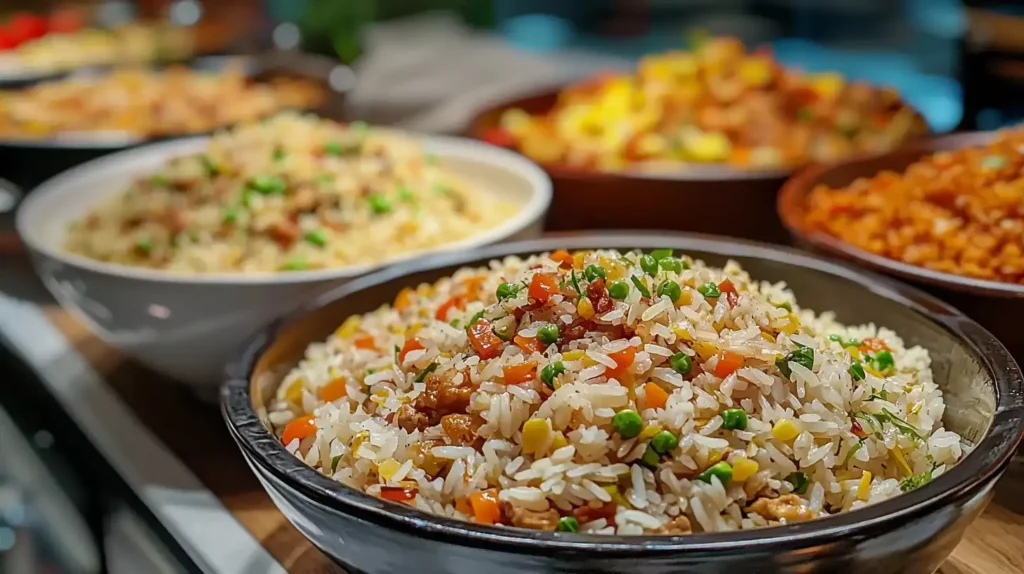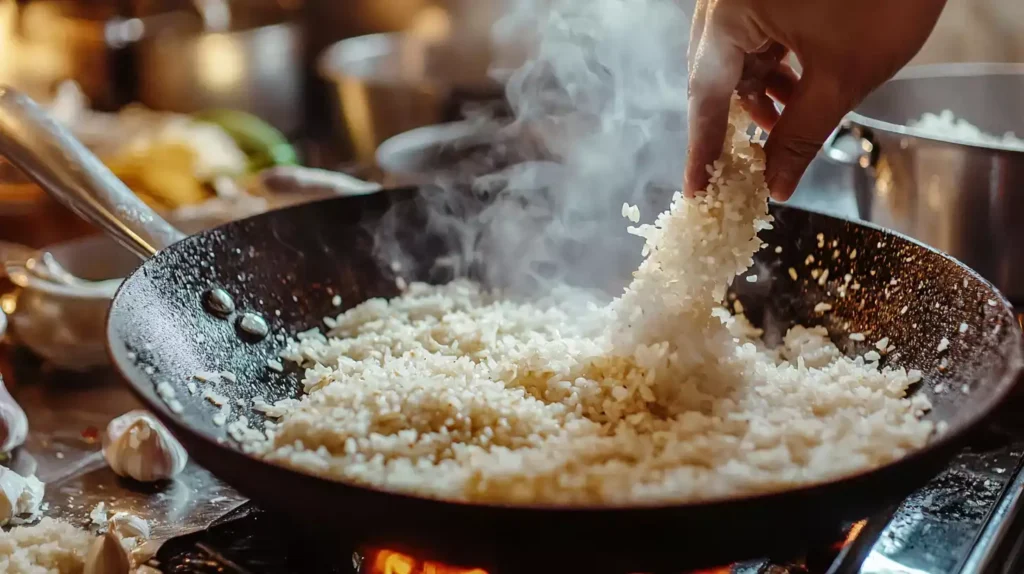The question, “How do you keep rice from getting mushy in soup?” is a common concern for many home cooks. There’s nothing more disappointing than a perfectly crafted soup, ruined by mushy, overcooked rice. This article is your ultimate guide to achieving that perfect texture every time. You will learn why rice gets mushy, how to choose the right rice variety, and essential cooking techniques to ensure your rice remains perfectly textured and not a soggy mess in your soup. With these tips, you’ll be able to make amazing, perfectly textured rice in soups at home, every time.

Table of Contents
Understanding Why Rice Gets Mushy in Soup
When you’re aiming for that perfect bowl of soup with well-cooked, firm grains of rice, it’s important to understand why it sometimes doesn’t turn out the way you want. Several factors can contribute to mushy rice, and being aware of these potential problems is the first step in mastering the art of cooking rice in soups. Knowing the science behind it and common cooking errors will help you always avoid these issues.
The Science Behind Mushy Rice
Mushy rice in soup is typically a result of excess starch being released from the grains during cooking. Rice grains contain starch, which is a carbohydrate that absorbs water. When cooked, the starch granules swell and eventually break down, creating a gelatinous and sticky consistency. Some rice varieties release more starch than others, making them more prone to becoming mushy, especially when cooked for extended periods, or when cooked in high heat. The more starch that is released the mushier the rice will be, impacting the texture of your soup.
Common Mistakes That Lead to Mushy Rice
Many common cooking mistakes can lead to mushy rice. Overcooking is the most common cause, since this allows the grains to absorb too much liquid, resulting in a soft, mushy texture. Another common mistake is using the wrong type of rice, since some varieties, like short-grain rice, are more prone to releasing starch and becoming mushy, than others. Excessive stirring while cooking also promotes starch release, contributing to mushiness. Finally, using the wrong ratio of liquid to rice can be a contributing factor to the mushy result.
The Impact of Starch on Soup Texture
When rice releases excessive starch into the soup, it will not only impact the texture of the grains, but also the texture of your soup. This starch acts as a thickening agent, resulting in a soup that is too thick and with a gluey consistency. This altered texture can greatly affect the overall eating experience, turning a delicious, comforting soup into a less palatable dish. Knowing how the starch interacts in the soup is essential to control its consistency and achieve the perfect texture.
Selecting the Right Rice for Soup

Choosing the right type of rice is the first step in preventing mushy results in soups. Different types of rice have varying levels of starch, which impact their texture and cooking behavior. Selecting the correct rice is the key to creating a satisfying and perfectly textured rice soup, and it is a step that should not be overlooked.
Top Rice Choices That Resist Mushiness
For the best results in preventing mushy rice in soup, always choose varieties that have a lower starch content. Long-grain rice is a great choice as it remains firm and separate, even after being cooked in liquids. Parboiled rice, also known as converted rice, is another excellent option since it has been partially pre-cooked, resulting in a grain that is more resilient. Basmati rice, known for its distinctive aroma and flavor, is also a good choice due to its lower starch content. Choosing these types will help you get better results.
Rice Varieties to Avoid to Prevent Mushiness
There are some types of rice that you should avoid if you are cooking rice in soup. Short-grain rice, like the one used in sushi, has a very high starch content, which results in a mushy texture. Arborio rice, often used in risotto, is also a type to avoid, because its high starch will result in a very creamy texture. Both of these types should be avoided if you want a perfectly textured rice in your soups. By selecting the correct type you will be able to achieve the perfect texture, which is key when making a delicious soup.
How Rice Type Impacts Soup Texture and Flavor
The type of rice that you choose not only affects the texture of your soup but also greatly impacts its flavor. Long-grain rice provides a light and fluffy texture, while parboiled rice offers a firmer and more defined grain. Basmati rice has a distinctive, nutty flavor and a delicate aroma that can enhance your dish. The best way to discover what type you like the most is to experiment with different types of rice to see how they perform when making soups. Choosing the right rice will greatly impact the results of your dish, making it an important consideration. You should also always be aware of the nutritional facts of each type of rice you decide to use.
Essential Techniques to Prevent Mushy Rice
Besides choosing the correct rice, it is important to use proper cooking techniques, and pay attention to a few important details, that can greatly impact the final results of your dish. By using the proper techniques, you will be able to master the art of cooking rice in soup, and achieve the results that you are aiming for. The balance between liquid, cooking time and temperature, will all contribute to the perfect bowl of soup.
The Ideal Rice-to-Liquid Ratio
Achieving the correct balance between rice and liquid is crucial when preventing mushy rice. While specific proportions can vary based on the type of rice and the desired consistency of the soup, a good guideline is to start with a 2:1 ratio of liquid to rice. However, always follow the instructions of your specific recipe, since certain rice varieties will need slightly different amounts of liquid. Always use the correct measurements, to make sure that you don’t use too much or too little liquid. Using this measurement as a base you can then adjust accordingly, based on your preferences.
The Right Time to Add Rice to Soup
The timing of when to add the rice to your soup can greatly affect the texture of the rice in the final dish. Adding rice too early in the cooking process can cause it to become overcooked, leading to mushiness. It is always best to add rice in the last 20 to 25 minutes of cooking, when the soup is simmering.
If you are using precooked rice, you should add it at the very end, right before serving to ensure it does not overcook and become mushy. Paying attention to the timing is very important when cooking rice in soup. If you are looking for an additional flavor boost, you should always consider adding a squeeze of lime to your soup, after cooking.
Controlling Simmering Temperature and Time
Maintaining the correct simmering temperature and cooking time are essential when cooking rice in soup. High heat can cause the rice to cook too fast, resulting in an uneven and mushy texture. Low heat is always the best option, as it allows the rice to cook gradually, without absorbing too much liquid. Adjusting the simmering time based on the type of rice you are using will also help you achieve perfect results. Remember that the correct heat and time, are always essential when making the perfect rice soup.
How Stirring Impacts Rice Texture
While it is important to stir to prevent rice from sticking to the pot, over stirring can be a very big problem. Excessive stirring of rice releases starch, contributing to the mushy texture, making the soup thicker than you want it. Always reduce your stirring as much as possible, once the rice is added. Gentle stirring is always enough to keep the rice from sticking to the bottom of the pot.
Advanced Tips for Perfect Rice in Soup

Beyond the basic techniques, there are some advanced tips that can greatly improve the texture of the rice in your soups. These techniques, such as parboiling or rinsing your rice before cooking, will ensure you achieve the best result when preparing a delicious and perfect soup.
Parboiling Rice Before Adding
Parboiling the rice before adding it to the soup is a good way to reduce the risk of mushiness. This can be done by partially cooking the rice in boiling water for about 5-10 minutes, before draining it and adding it to your soup. The parboiling process creates a more robust grain that holds its shape and texture when added to liquids. This method is excellent when you want to guarantee that your rice doesn’t become mushy.
Rinsing Rice to Remove Excess Starch
Rinsing the rice before adding it to the soup, will remove the excess starch that is on the surface of the grain, which greatly helps prevent it from becoming mushy. You should rinse the rice under cold water until the water becomes clear. This extra step will reduce the amount of starch released into the soup, helping it keep its texture. Always try to rinse your rice before adding it to soups, to make sure you get the best results. If you are using precooked rice, there is no need to rinse it.
Using Precooked or Leftover Rice
One of the easiest ways to prevent mushy rice is to use precooked or leftover rice. If you want to use precooked rice, you should add it at the end of the cooking process, just before serving. This method avoids the problems of overcooking, and is a very simple way to save time and prevent mushiness. Using leftover rice is a convenient option and you can also use it in many other recipes.
Troubleshooting Common Rice Soup Issues
Even with the best methods, you might face problems from time to time. Knowing how to deal with these situations will help you always create the perfect soup. With the help of these tips you will be able to solve the most common issues when cooking rice in soup.
Rescue Tips for Overcooked Rice in Soup
If the rice has overcooked and become mushy in your soup, there are some steps that you can take to solve this issue. You can drain the soup using a mesh strainer, rinsing the rice with cold water to remove excess starch, which can also help stop the cooking process. Though the texture of the rice may be compromised, it is still edible. Also, this mushy rice can be used to add some thickness to other soups. This is a great way to avoid wasting food.
Handling Undercooked Rice
If you find that the rice in your soup is undercooked, you can easily fix it. You can simply add a bit more broth or water, and continue simmering the soup until the rice is cooked. Always monitor it often to make sure that you don’t overcook it. This is a simple solution to solve this common problem and allows you to continue enjoying your meal. Be sure to use low heat so that you don’t overcook the rice and make other ingredients mushy.
Adjusting Soup Consistency if It’s Too Thick
Sometimes, even if the rice is cooked perfectly, your soup might be too thick due to excess starch that was released. To thin out the soup, you can simply add more broth or hot water. Always add it gradually, stirring, until you reach your desired consistency. This can easily correct this issue, and help you achieve the perfect soup that you are looking for. If you are adding water, make sure that is is hot, to prevent cooling the soup down.
Flavor Enhancements and Serving Suggestions
To elevate your rice soup, you can always add some flavorful ingredients and serve it in an attractive way. The proper serving presentation enhances the overall experience. Garnishes add texture, taste, and visual appeal.
Enhancing Flavor with Aromatics, Herbs, and Spices
Adding a variety of aromatics, herbs, and spices will greatly enhance the flavor of your soup. Aromatics like garlic, onions, and ginger will provide a great base. Herbs, like bay leaves, thyme, or rosemary, will add depth, and spices like cumin, turmeric, or paprika will add a warm note that is very satisfying. The combination you choose is very personal. Try to experiment with different combinations to find what you like best. These simple additions will greatly impact the flavor of the dish.
Pairing Suggestions to Elevate Your Rice Soup
Serving your rice soup with a side of crusty bread will greatly enhance the experience. A fresh salad with vinaigrette can add a light, refreshing touch. A small bowl of lemon slices can also help brighten the flavors of the soup. A side of grilled vegetables or a light side dish can make your meal more balanced and satisfying.
Creative Ideas for Garnishing Rice Soup
Garnishing your rice soup with fresh herbs, such as parsley, or cilantro will bring a vibrant touch. A swirl of cream or yogurt can add richness and a beautiful presentation. A sprinkle of toasted sesame seeds or some crushed nuts adds a textural contrast and a nutty flavor that elevates your soup. With these simple ideas, you can transform a simple bowl of rice soup into a beautifully presented, visually pleasing dish. You should always taste before you serve to ensure that you add all the right garnishes for each type of soup that you are making.
Frequently Asked Questions (FAQs)
Can I add rice directly to soup?
Yes, you can add rice directly to soup but you have to make sure that you use the right techniques and the right type of rice. It is essential to select the right variety of rice (long-grain, basmati or parboiled). You also have to add it at the right time and not overcook it, or it will turn mushy. When done correctly, adding rice directly to the soup will create a delicious and time-saving meal.
How do you keep rice from getting mushy in soup?
To prevent mushy rice, you should always use rice varieties that are low in starch, such as long-grain, basmati, or parboiled rice. Make sure to rinse your rice to remove the excess starch, use the correct ratio of liquid to rice, and make sure you add the rice in the last 20-25 minutes of cooking. Over stirring can also result in mushy rice, so avoid that. With these simple tips you can make sure that your rice doesn’t get mushy in your soup.
Do you cook the chicken before putting it in soup?
You don’t have to cook chicken before putting it in soup. You can add raw chicken directly to the soup, but you have to ensure that it is fully cooked before serving. Adding raw chicken will create a richer flavor to the broth. You can also add cooked chicken towards the end of the cooking process to save time. Both options are great.
How to thicken up chicken and rice soup?
You can thicken chicken and rice soup by simmering it uncovered for longer allowing some of the liquid to evaporate. You can also use a mix of flour or cornstarch and water, adding it to the soup and stirring until it reaches your desired consistency. Another option is to use an egg yolk to thicken it, adding it while using low heat to prevent it from scrambling. All of these techniques are simple and easy to do at home.
Conclusion
Mastering the art of cooking rice in soup without it turning mushy is all about knowing what techniques to use and paying attention to a few key points, like using the right type of rice and the right liquid ratios. With the correct techniques, and tips you can create the perfect soup with perfectly cooked rice every time, and avoid the dreaded mushy texture. So, go ahead and try these tips and discover how delicious the perfect rice soup can be. Now that you know how do you keep rice from getting mushy in soup, you can make delicious recipes at home with ease.
For More Articles Links:

